Human Resource Management Report: Global HRM and Productivity
VerifiedAdded on 2020/04/15
|23
|6713
|233
Report
AI Summary
This report provides a comprehensive overview of Human Resource Management (HRM), encompassing key aspects such as strategic planning, HRM functions, and global contexts. It begins by defining HRM's role in organizations, emphasizing strategic planning and its processes like staffing, policy development, compensation, retention, training, and regulatory compliance. The report then delves into strategic HRM, highlighting its integration with organizational goals, culture, and competitive advantages. It examines the functions of strategic HRM, including employee relations, performance management, and recruitment, alongside the importance of employee needs. Furthermore, the report explores the global context of HRM, discussing recruitment, training, compensation, and legal considerations in international settings. Finally, the report addresses improving organizational productivity, emphasizing the importance of trust, goal setting, employee engagement, and performance recognition. This report is designed to provide insights into optimizing HRM practices for organizational success.
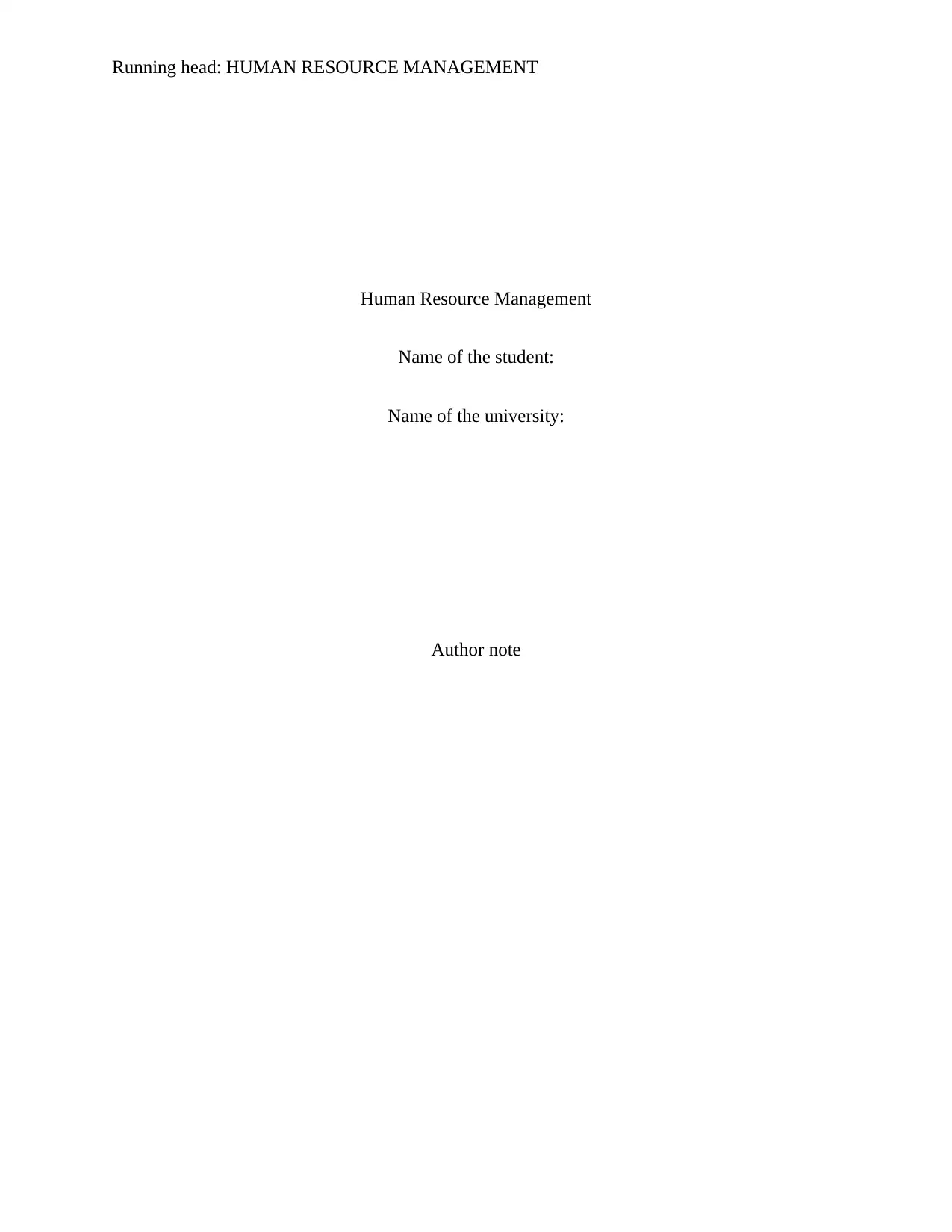
Running head: HUMAN RESOURCE MANAGEMENT
Human Resource Management
Name of the student:
Name of the university:
Author note
Human Resource Management
Name of the student:
Name of the university:
Author note
Paraphrase This Document
Need a fresh take? Get an instant paraphrase of this document with our AI Paraphraser
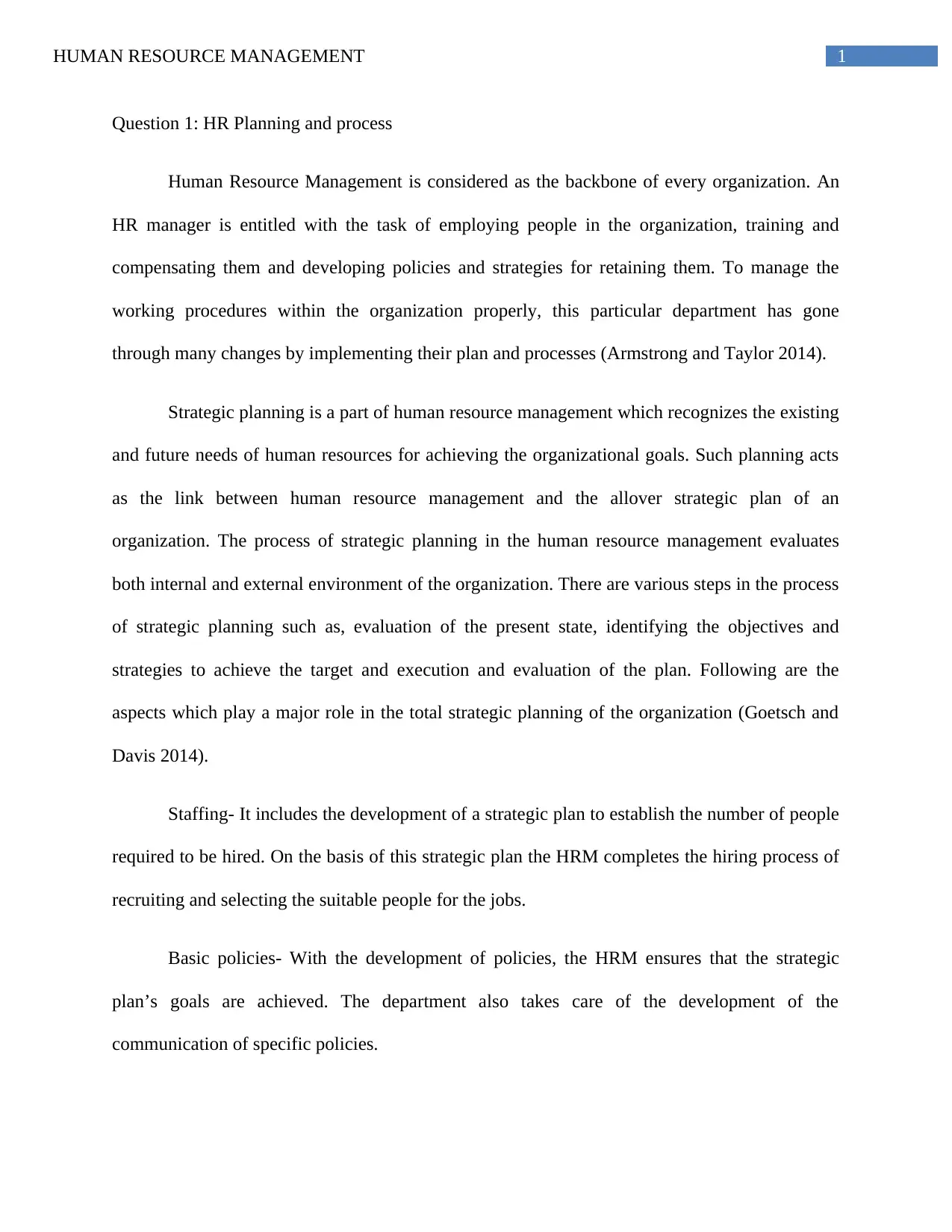
1HUMAN RESOURCE MANAGEMENT
Question 1: HR Planning and process
Human Resource Management is considered as the backbone of every organization. An
HR manager is entitled with the task of employing people in the organization, training and
compensating them and developing policies and strategies for retaining them. To manage the
working procedures within the organization properly, this particular department has gone
through many changes by implementing their plan and processes (Armstrong and Taylor 2014).
Strategic planning is a part of human resource management which recognizes the existing
and future needs of human resources for achieving the organizational goals. Such planning acts
as the link between human resource management and the allover strategic plan of an
organization. The process of strategic planning in the human resource management evaluates
both internal and external environment of the organization. There are various steps in the process
of strategic planning such as, evaluation of the present state, identifying the objectives and
strategies to achieve the target and execution and evaluation of the plan. Following are the
aspects which play a major role in the total strategic planning of the organization (Goetsch and
Davis 2014).
Staffing- It includes the development of a strategic plan to establish the number of people
required to be hired. On the basis of this strategic plan the HRM completes the hiring process of
recruiting and selecting the suitable people for the jobs.
Basic policies- With the development of policies, the HRM ensures that the strategic
plan’s goals are achieved. The department also takes care of the development of the
communication of specific policies.
Question 1: HR Planning and process
Human Resource Management is considered as the backbone of every organization. An
HR manager is entitled with the task of employing people in the organization, training and
compensating them and developing policies and strategies for retaining them. To manage the
working procedures within the organization properly, this particular department has gone
through many changes by implementing their plan and processes (Armstrong and Taylor 2014).
Strategic planning is a part of human resource management which recognizes the existing
and future needs of human resources for achieving the organizational goals. Such planning acts
as the link between human resource management and the allover strategic plan of an
organization. The process of strategic planning in the human resource management evaluates
both internal and external environment of the organization. There are various steps in the process
of strategic planning such as, evaluation of the present state, identifying the objectives and
strategies to achieve the target and execution and evaluation of the plan. Following are the
aspects which play a major role in the total strategic planning of the organization (Goetsch and
Davis 2014).
Staffing- It includes the development of a strategic plan to establish the number of people
required to be hired. On the basis of this strategic plan the HRM completes the hiring process of
recruiting and selecting the suitable people for the jobs.
Basic policies- With the development of policies, the HRM ensures that the strategic
plan’s goals are achieved. The department also takes care of the development of the
communication of specific policies.
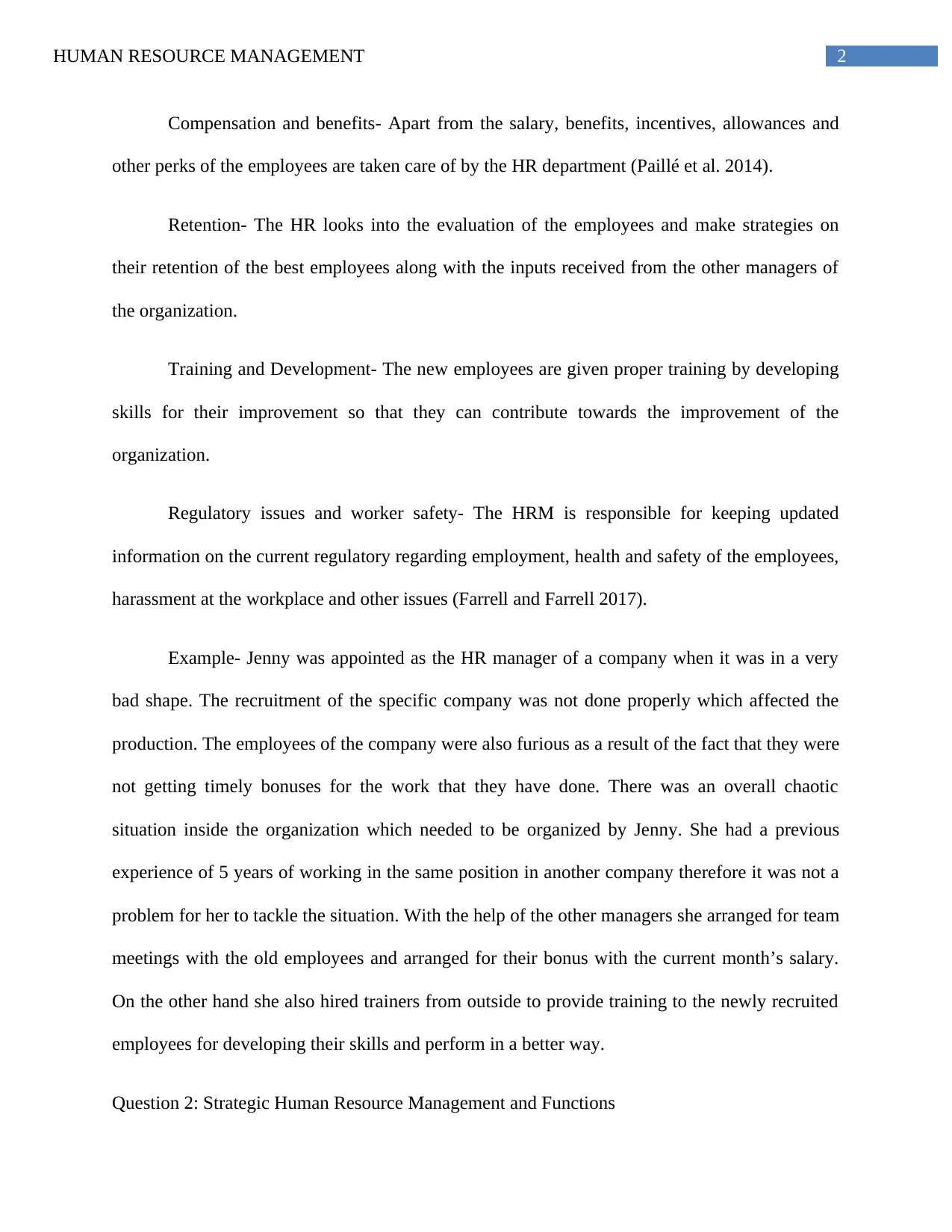
2HUMAN RESOURCE MANAGEMENT
Compensation and benefits- Apart from the salary, benefits, incentives, allowances and
other perks of the employees are taken care of by the HR department (Paillé et al. 2014).
Retention- The HR looks into the evaluation of the employees and make strategies on
their retention of the best employees along with the inputs received from the other managers of
the organization.
Training and Development- The new employees are given proper training by developing
skills for their improvement so that they can contribute towards the improvement of the
organization.
Regulatory issues and worker safety- The HRM is responsible for keeping updated
information on the current regulatory regarding employment, health and safety of the employees,
harassment at the workplace and other issues (Farrell and Farrell 2017).
Example- Jenny was appointed as the HR manager of a company when it was in a very
bad shape. The recruitment of the specific company was not done properly which affected the
production. The employees of the company were also furious as a result of the fact that they were
not getting timely bonuses for the work that they have done. There was an overall chaotic
situation inside the organization which needed to be organized by Jenny. She had a previous
experience of 5 years of working in the same position in another company therefore it was not a
problem for her to tackle the situation. With the help of the other managers she arranged for team
meetings with the old employees and arranged for their bonus with the current month’s salary.
On the other hand she also hired trainers from outside to provide training to the newly recruited
employees for developing their skills and perform in a better way.
Question 2: Strategic Human Resource Management and Functions
Compensation and benefits- Apart from the salary, benefits, incentives, allowances and
other perks of the employees are taken care of by the HR department (Paillé et al. 2014).
Retention- The HR looks into the evaluation of the employees and make strategies on
their retention of the best employees along with the inputs received from the other managers of
the organization.
Training and Development- The new employees are given proper training by developing
skills for their improvement so that they can contribute towards the improvement of the
organization.
Regulatory issues and worker safety- The HRM is responsible for keeping updated
information on the current regulatory regarding employment, health and safety of the employees,
harassment at the workplace and other issues (Farrell and Farrell 2017).
Example- Jenny was appointed as the HR manager of a company when it was in a very
bad shape. The recruitment of the specific company was not done properly which affected the
production. The employees of the company were also furious as a result of the fact that they were
not getting timely bonuses for the work that they have done. There was an overall chaotic
situation inside the organization which needed to be organized by Jenny. She had a previous
experience of 5 years of working in the same position in another company therefore it was not a
problem for her to tackle the situation. With the help of the other managers she arranged for team
meetings with the old employees and arranged for their bonus with the current month’s salary.
On the other hand she also hired trainers from outside to provide training to the newly recruited
employees for developing their skills and perform in a better way.
Question 2: Strategic Human Resource Management and Functions
⊘ This is a preview!⊘
Do you want full access?
Subscribe today to unlock all pages.

Trusted by 1+ million students worldwide
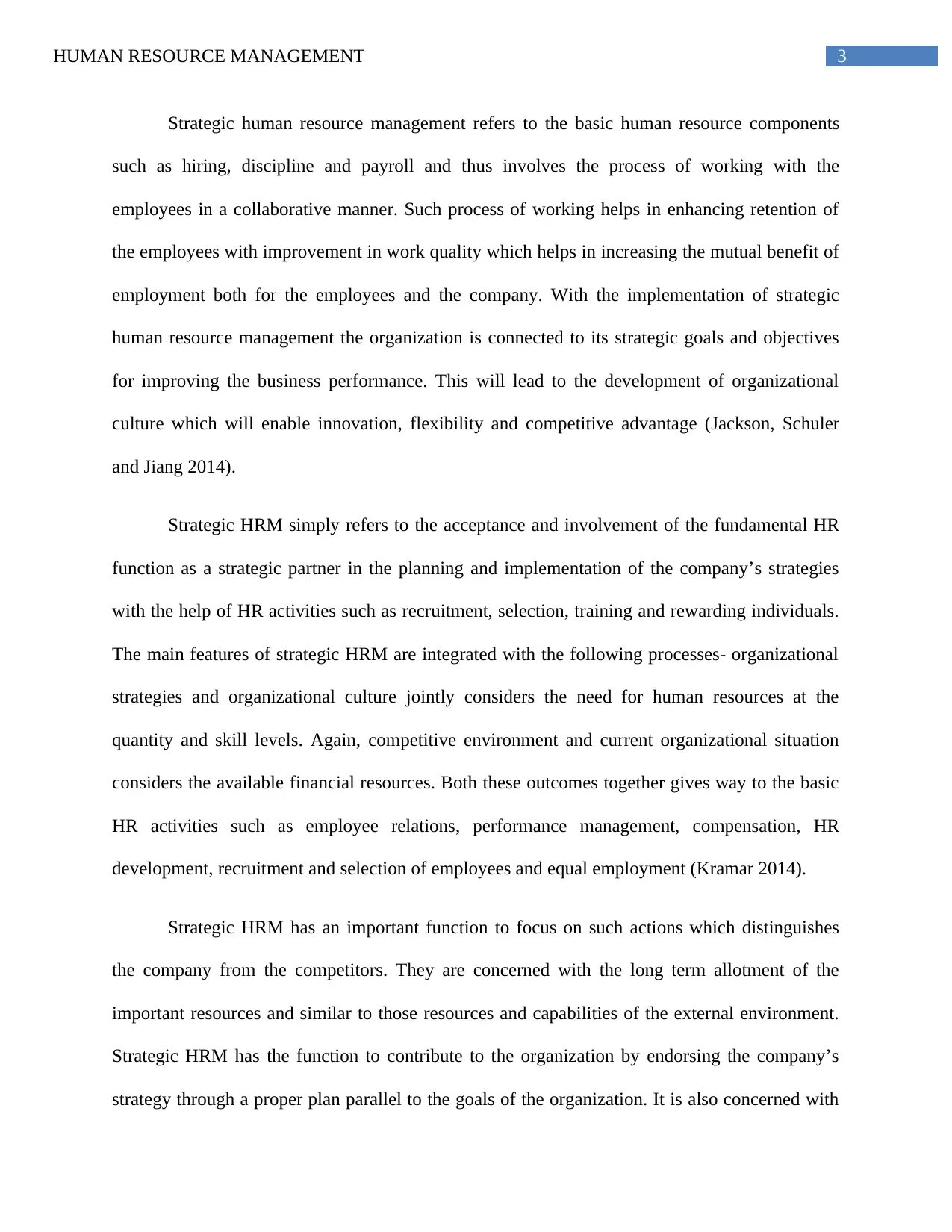
3HUMAN RESOURCE MANAGEMENT
Strategic human resource management refers to the basic human resource components
such as hiring, discipline and payroll and thus involves the process of working with the
employees in a collaborative manner. Such process of working helps in enhancing retention of
the employees with improvement in work quality which helps in increasing the mutual benefit of
employment both for the employees and the company. With the implementation of strategic
human resource management the organization is connected to its strategic goals and objectives
for improving the business performance. This will lead to the development of organizational
culture which will enable innovation, flexibility and competitive advantage (Jackson, Schuler
and Jiang 2014).
Strategic HRM simply refers to the acceptance and involvement of the fundamental HR
function as a strategic partner in the planning and implementation of the company’s strategies
with the help of HR activities such as recruitment, selection, training and rewarding individuals.
The main features of strategic HRM are integrated with the following processes- organizational
strategies and organizational culture jointly considers the need for human resources at the
quantity and skill levels. Again, competitive environment and current organizational situation
considers the available financial resources. Both these outcomes together gives way to the basic
HR activities such as employee relations, performance management, compensation, HR
development, recruitment and selection of employees and equal employment (Kramar 2014).
Strategic HRM has an important function to focus on such actions which distinguishes
the company from the competitors. They are concerned with the long term allotment of the
important resources and similar to those resources and capabilities of the external environment.
Strategic HRM has the function to contribute to the organization by endorsing the company’s
strategy through a proper plan parallel to the goals of the organization. It is also concerned with
Strategic human resource management refers to the basic human resource components
such as hiring, discipline and payroll and thus involves the process of working with the
employees in a collaborative manner. Such process of working helps in enhancing retention of
the employees with improvement in work quality which helps in increasing the mutual benefit of
employment both for the employees and the company. With the implementation of strategic
human resource management the organization is connected to its strategic goals and objectives
for improving the business performance. This will lead to the development of organizational
culture which will enable innovation, flexibility and competitive advantage (Jackson, Schuler
and Jiang 2014).
Strategic HRM simply refers to the acceptance and involvement of the fundamental HR
function as a strategic partner in the planning and implementation of the company’s strategies
with the help of HR activities such as recruitment, selection, training and rewarding individuals.
The main features of strategic HRM are integrated with the following processes- organizational
strategies and organizational culture jointly considers the need for human resources at the
quantity and skill levels. Again, competitive environment and current organizational situation
considers the available financial resources. Both these outcomes together gives way to the basic
HR activities such as employee relations, performance management, compensation, HR
development, recruitment and selection of employees and equal employment (Kramar 2014).
Strategic HRM has an important function to focus on such actions which distinguishes
the company from the competitors. They are concerned with the long term allotment of the
important resources and similar to those resources and capabilities of the external environment.
Strategic HRM has the function to contribute to the organization by endorsing the company’s
strategy through a proper plan parallel to the goals of the organization. It is also concerned with
Paraphrase This Document
Need a fresh take? Get an instant paraphrase of this document with our AI Paraphraser
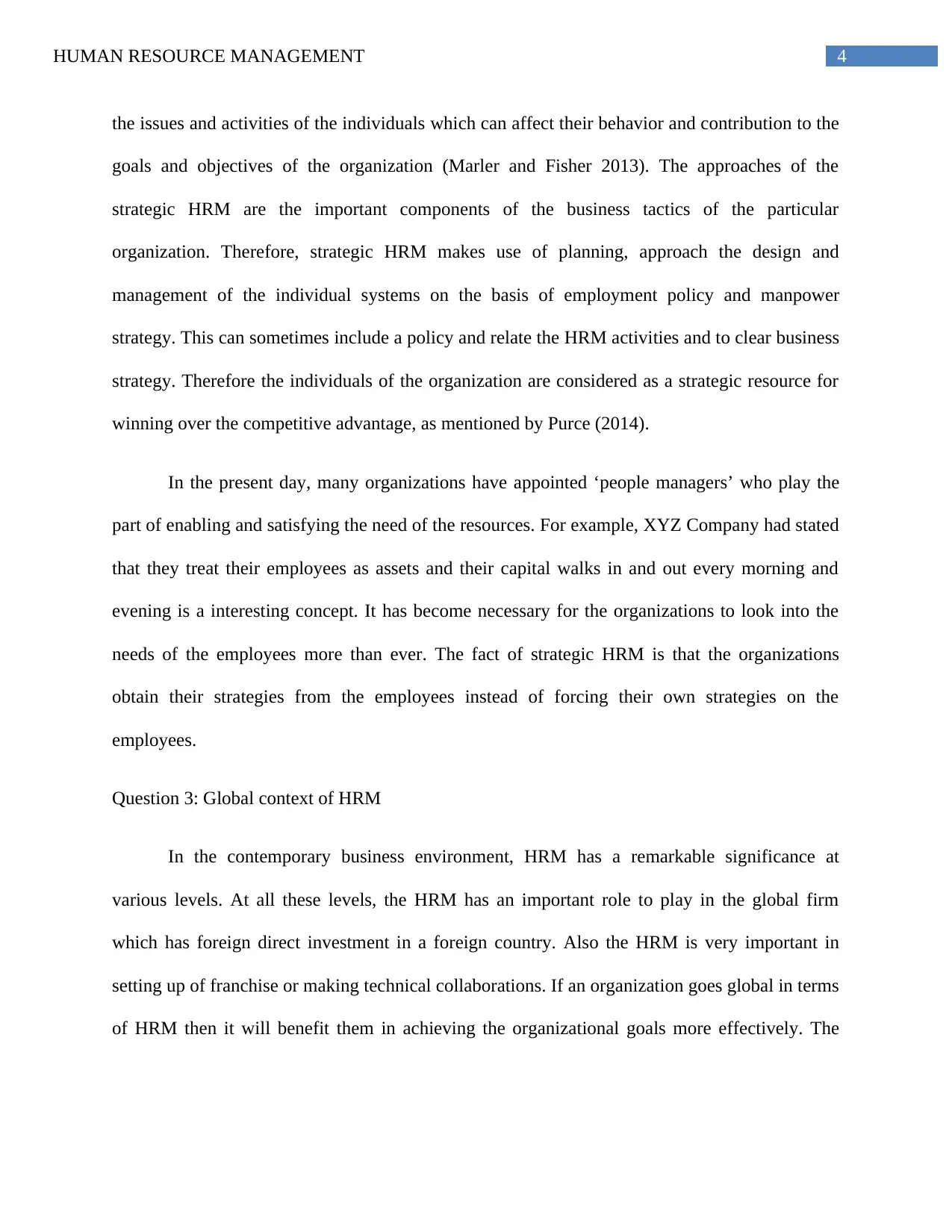
4HUMAN RESOURCE MANAGEMENT
the issues and activities of the individuals which can affect their behavior and contribution to the
goals and objectives of the organization (Marler and Fisher 2013). The approaches of the
strategic HRM are the important components of the business tactics of the particular
organization. Therefore, strategic HRM makes use of planning, approach the design and
management of the individual systems on the basis of employment policy and manpower
strategy. This can sometimes include a policy and relate the HRM activities and to clear business
strategy. Therefore the individuals of the organization are considered as a strategic resource for
winning over the competitive advantage, as mentioned by Purce (2014).
In the present day, many organizations have appointed ‘people managers’ who play the
part of enabling and satisfying the need of the resources. For example, XYZ Company had stated
that they treat their employees as assets and their capital walks in and out every morning and
evening is a interesting concept. It has become necessary for the organizations to look into the
needs of the employees more than ever. The fact of strategic HRM is that the organizations
obtain their strategies from the employees instead of forcing their own strategies on the
employees.
Question 3: Global context of HRM
In the contemporary business environment, HRM has a remarkable significance at
various levels. At all these levels, the HRM has an important role to play in the global firm
which has foreign direct investment in a foreign country. Also the HRM is very important in
setting up of franchise or making technical collaborations. If an organization goes global in terms
of HRM then it will benefit them in achieving the organizational goals more effectively. The
the issues and activities of the individuals which can affect their behavior and contribution to the
goals and objectives of the organization (Marler and Fisher 2013). The approaches of the
strategic HRM are the important components of the business tactics of the particular
organization. Therefore, strategic HRM makes use of planning, approach the design and
management of the individual systems on the basis of employment policy and manpower
strategy. This can sometimes include a policy and relate the HRM activities and to clear business
strategy. Therefore the individuals of the organization are considered as a strategic resource for
winning over the competitive advantage, as mentioned by Purce (2014).
In the present day, many organizations have appointed ‘people managers’ who play the
part of enabling and satisfying the need of the resources. For example, XYZ Company had stated
that they treat their employees as assets and their capital walks in and out every morning and
evening is a interesting concept. It has become necessary for the organizations to look into the
needs of the employees more than ever. The fact of strategic HRM is that the organizations
obtain their strategies from the employees instead of forcing their own strategies on the
employees.
Question 3: Global context of HRM
In the contemporary business environment, HRM has a remarkable significance at
various levels. At all these levels, the HRM has an important role to play in the global firm
which has foreign direct investment in a foreign country. Also the HRM is very important in
setting up of franchise or making technical collaborations. If an organization goes global in terms
of HRM then it will benefit them in achieving the organizational goals more effectively. The
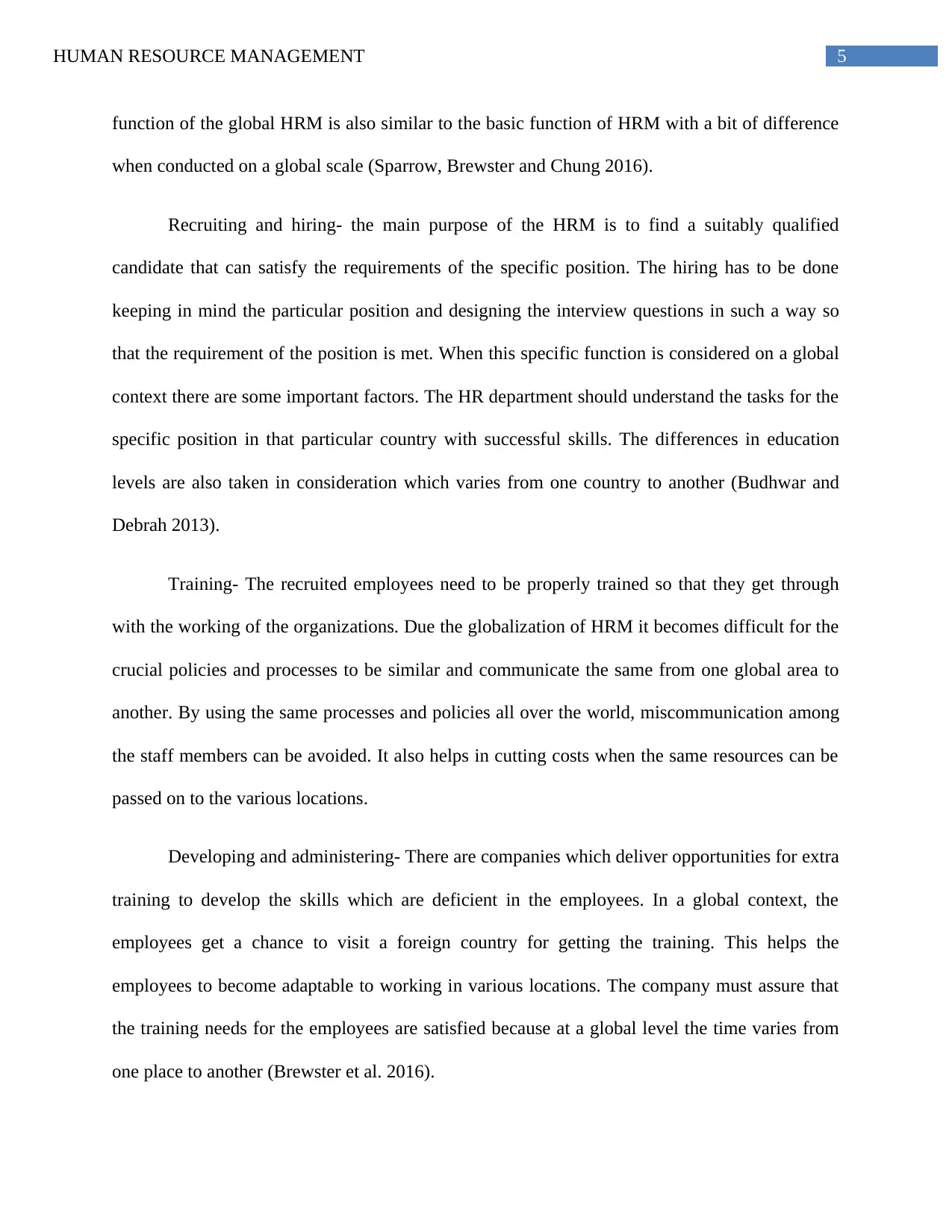
5HUMAN RESOURCE MANAGEMENT
function of the global HRM is also similar to the basic function of HRM with a bit of difference
when conducted on a global scale (Sparrow, Brewster and Chung 2016).
Recruiting and hiring- the main purpose of the HRM is to find a suitably qualified
candidate that can satisfy the requirements of the specific position. The hiring has to be done
keeping in mind the particular position and designing the interview questions in such a way so
that the requirement of the position is met. When this specific function is considered on a global
context there are some important factors. The HR department should understand the tasks for the
specific position in that particular country with successful skills. The differences in education
levels are also taken in consideration which varies from one country to another (Budhwar and
Debrah 2013).
Training- The recruited employees need to be properly trained so that they get through
with the working of the organizations. Due the globalization of HRM it becomes difficult for the
crucial policies and processes to be similar and communicate the same from one global area to
another. By using the same processes and policies all over the world, miscommunication among
the staff members can be avoided. It also helps in cutting costs when the same resources can be
passed on to the various locations.
Developing and administering- There are companies which deliver opportunities for extra
training to develop the skills which are deficient in the employees. In a global context, the
employees get a chance to visit a foreign country for getting the training. This helps the
employees to become adaptable to working in various locations. The company must assure that
the training needs for the employees are satisfied because at a global level the time varies from
one place to another (Brewster et al. 2016).
function of the global HRM is also similar to the basic function of HRM with a bit of difference
when conducted on a global scale (Sparrow, Brewster and Chung 2016).
Recruiting and hiring- the main purpose of the HRM is to find a suitably qualified
candidate that can satisfy the requirements of the specific position. The hiring has to be done
keeping in mind the particular position and designing the interview questions in such a way so
that the requirement of the position is met. When this specific function is considered on a global
context there are some important factors. The HR department should understand the tasks for the
specific position in that particular country with successful skills. The differences in education
levels are also taken in consideration which varies from one country to another (Budhwar and
Debrah 2013).
Training- The recruited employees need to be properly trained so that they get through
with the working of the organizations. Due the globalization of HRM it becomes difficult for the
crucial policies and processes to be similar and communicate the same from one global area to
another. By using the same processes and policies all over the world, miscommunication among
the staff members can be avoided. It also helps in cutting costs when the same resources can be
passed on to the various locations.
Developing and administering- There are companies which deliver opportunities for extra
training to develop the skills which are deficient in the employees. In a global context, the
employees get a chance to visit a foreign country for getting the training. This helps the
employees to become adaptable to working in various locations. The company must assure that
the training needs for the employees are satisfied because at a global level the time varies from
one place to another (Brewster et al. 2016).
⊘ This is a preview!⊘
Do you want full access?
Subscribe today to unlock all pages.

Trusted by 1+ million students worldwide
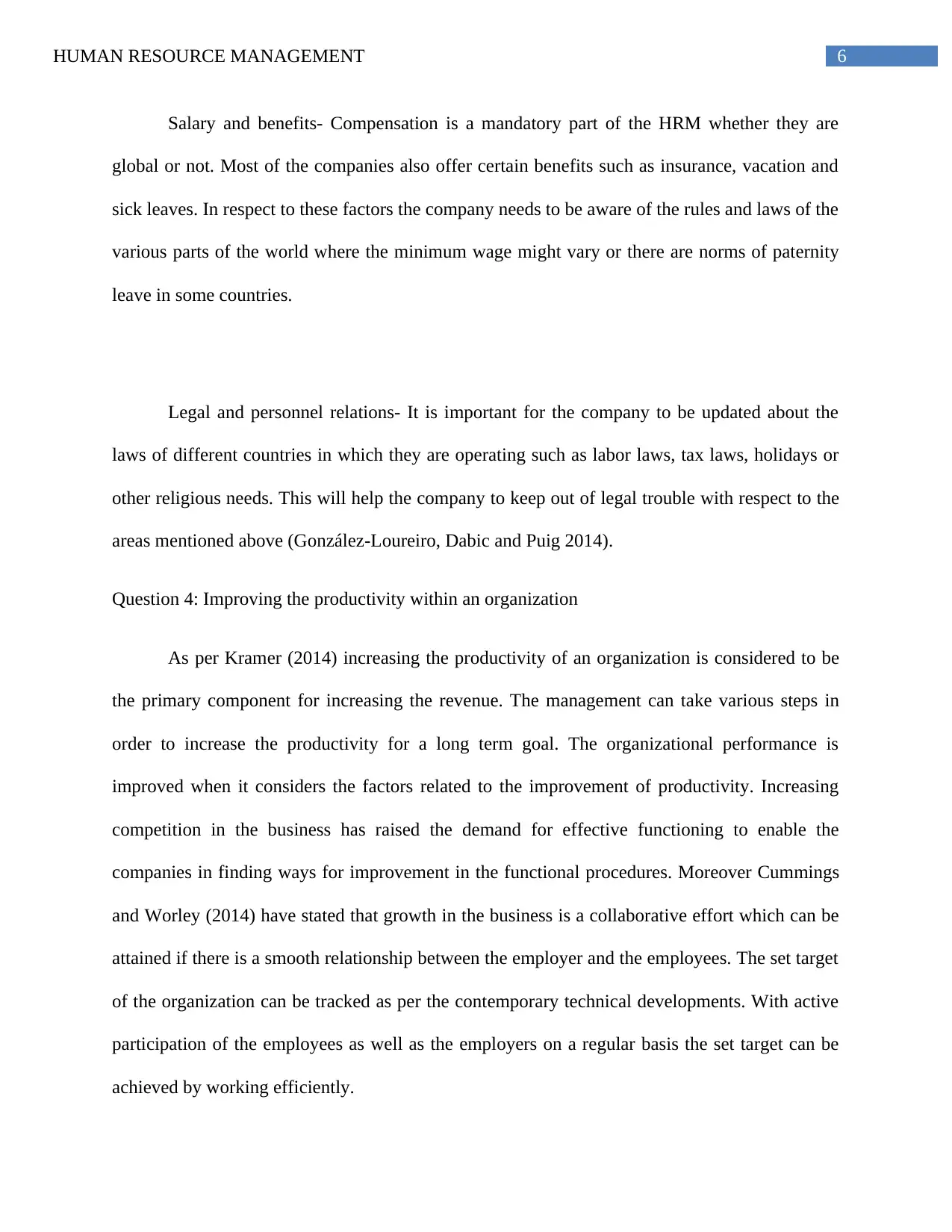
6HUMAN RESOURCE MANAGEMENT
Salary and benefits- Compensation is a mandatory part of the HRM whether they are
global or not. Most of the companies also offer certain benefits such as insurance, vacation and
sick leaves. In respect to these factors the company needs to be aware of the rules and laws of the
various parts of the world where the minimum wage might vary or there are norms of paternity
leave in some countries.
Legal and personnel relations- It is important for the company to be updated about the
laws of different countries in which they are operating such as labor laws, tax laws, holidays or
other religious needs. This will help the company to keep out of legal trouble with respect to the
areas mentioned above (González-Loureiro, Dabic and Puig 2014).
Question 4: Improving the productivity within an organization
As per Kramer (2014) increasing the productivity of an organization is considered to be
the primary component for increasing the revenue. The management can take various steps in
order to increase the productivity for a long term goal. The organizational performance is
improved when it considers the factors related to the improvement of productivity. Increasing
competition in the business has raised the demand for effective functioning to enable the
companies in finding ways for improvement in the functional procedures. Moreover Cummings
and Worley (2014) have stated that growth in the business is a collaborative effort which can be
attained if there is a smooth relationship between the employer and the employees. The set target
of the organization can be tracked as per the contemporary technical developments. With active
participation of the employees as well as the employers on a regular basis the set target can be
achieved by working efficiently.
Salary and benefits- Compensation is a mandatory part of the HRM whether they are
global or not. Most of the companies also offer certain benefits such as insurance, vacation and
sick leaves. In respect to these factors the company needs to be aware of the rules and laws of the
various parts of the world where the minimum wage might vary or there are norms of paternity
leave in some countries.
Legal and personnel relations- It is important for the company to be updated about the
laws of different countries in which they are operating such as labor laws, tax laws, holidays or
other religious needs. This will help the company to keep out of legal trouble with respect to the
areas mentioned above (González-Loureiro, Dabic and Puig 2014).
Question 4: Improving the productivity within an organization
As per Kramer (2014) increasing the productivity of an organization is considered to be
the primary component for increasing the revenue. The management can take various steps in
order to increase the productivity for a long term goal. The organizational performance is
improved when it considers the factors related to the improvement of productivity. Increasing
competition in the business has raised the demand for effective functioning to enable the
companies in finding ways for improvement in the functional procedures. Moreover Cummings
and Worley (2014) have stated that growth in the business is a collaborative effort which can be
attained if there is a smooth relationship between the employer and the employees. The set target
of the organization can be tracked as per the contemporary technical developments. With active
participation of the employees as well as the employers on a regular basis the set target can be
achieved by working efficiently.
Paraphrase This Document
Need a fresh take? Get an instant paraphrase of this document with our AI Paraphraser
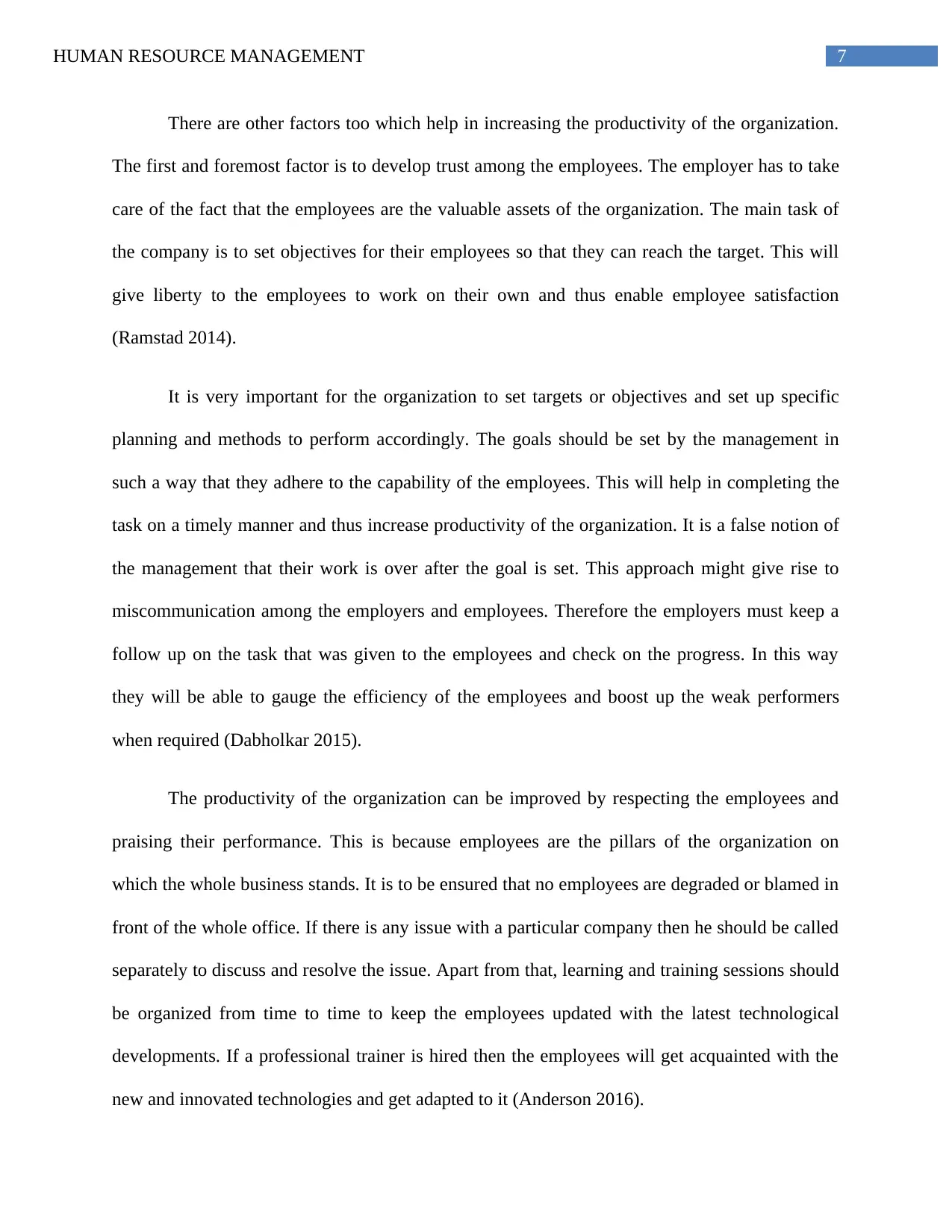
7HUMAN RESOURCE MANAGEMENT
There are other factors too which help in increasing the productivity of the organization.
The first and foremost factor is to develop trust among the employees. The employer has to take
care of the fact that the employees are the valuable assets of the organization. The main task of
the company is to set objectives for their employees so that they can reach the target. This will
give liberty to the employees to work on their own and thus enable employee satisfaction
(Ramstad 2014).
It is very important for the organization to set targets or objectives and set up specific
planning and methods to perform accordingly. The goals should be set by the management in
such a way that they adhere to the capability of the employees. This will help in completing the
task on a timely manner and thus increase productivity of the organization. It is a false notion of
the management that their work is over after the goal is set. This approach might give rise to
miscommunication among the employers and employees. Therefore the employers must keep a
follow up on the task that was given to the employees and check on the progress. In this way
they will be able to gauge the efficiency of the employees and boost up the weak performers
when required (Dabholkar 2015).
The productivity of the organization can be improved by respecting the employees and
praising their performance. This is because employees are the pillars of the organization on
which the whole business stands. It is to be ensured that no employees are degraded or blamed in
front of the whole office. If there is any issue with a particular company then he should be called
separately to discuss and resolve the issue. Apart from that, learning and training sessions should
be organized from time to time to keep the employees updated with the latest technological
developments. If a professional trainer is hired then the employees will get acquainted with the
new and innovated technologies and get adapted to it (Anderson 2016).
There are other factors too which help in increasing the productivity of the organization.
The first and foremost factor is to develop trust among the employees. The employer has to take
care of the fact that the employees are the valuable assets of the organization. The main task of
the company is to set objectives for their employees so that they can reach the target. This will
give liberty to the employees to work on their own and thus enable employee satisfaction
(Ramstad 2014).
It is very important for the organization to set targets or objectives and set up specific
planning and methods to perform accordingly. The goals should be set by the management in
such a way that they adhere to the capability of the employees. This will help in completing the
task on a timely manner and thus increase productivity of the organization. It is a false notion of
the management that their work is over after the goal is set. This approach might give rise to
miscommunication among the employers and employees. Therefore the employers must keep a
follow up on the task that was given to the employees and check on the progress. In this way
they will be able to gauge the efficiency of the employees and boost up the weak performers
when required (Dabholkar 2015).
The productivity of the organization can be improved by respecting the employees and
praising their performance. This is because employees are the pillars of the organization on
which the whole business stands. It is to be ensured that no employees are degraded or blamed in
front of the whole office. If there is any issue with a particular company then he should be called
separately to discuss and resolve the issue. Apart from that, learning and training sessions should
be organized from time to time to keep the employees updated with the latest technological
developments. If a professional trainer is hired then the employees will get acquainted with the
new and innovated technologies and get adapted to it (Anderson 2016).
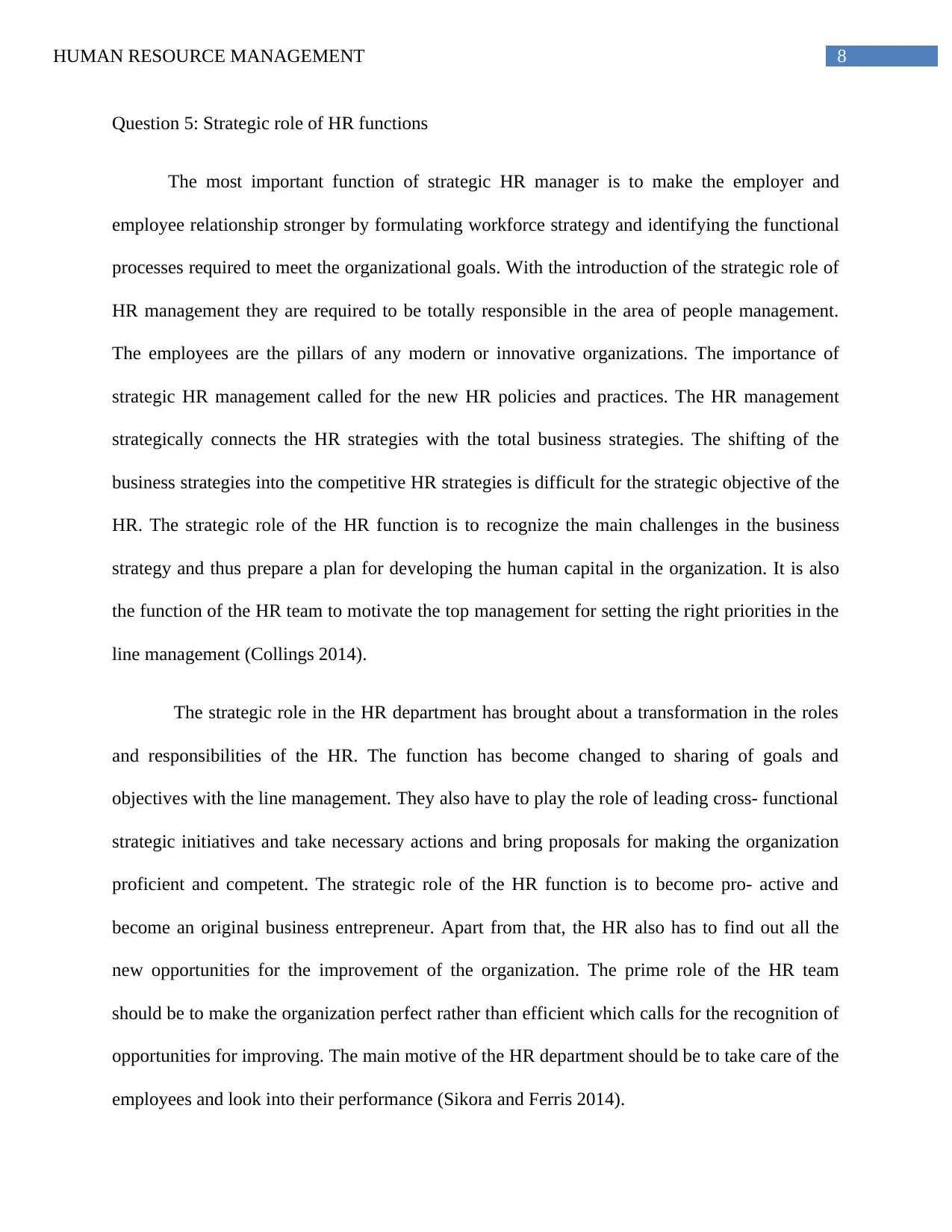
8HUMAN RESOURCE MANAGEMENT
Question 5: Strategic role of HR functions
The most important function of strategic HR manager is to make the employer and
employee relationship stronger by formulating workforce strategy and identifying the functional
processes required to meet the organizational goals. With the introduction of the strategic role of
HR management they are required to be totally responsible in the area of people management.
The employees are the pillars of any modern or innovative organizations. The importance of
strategic HR management called for the new HR policies and practices. The HR management
strategically connects the HR strategies with the total business strategies. The shifting of the
business strategies into the competitive HR strategies is difficult for the strategic objective of the
HR. The strategic role of the HR function is to recognize the main challenges in the business
strategy and thus prepare a plan for developing the human capital in the organization. It is also
the function of the HR team to motivate the top management for setting the right priorities in the
line management (Collings 2014).
The strategic role in the HR department has brought about a transformation in the roles
and responsibilities of the HR. The function has become changed to sharing of goals and
objectives with the line management. They also have to play the role of leading cross- functional
strategic initiatives and take necessary actions and bring proposals for making the organization
proficient and competent. The strategic role of the HR function is to become pro- active and
become an original business entrepreneur. Apart from that, the HR also has to find out all the
new opportunities for the improvement of the organization. The prime role of the HR team
should be to make the organization perfect rather than efficient which calls for the recognition of
opportunities for improving. The main motive of the HR department should be to take care of the
employees and look into their performance (Sikora and Ferris 2014).
Question 5: Strategic role of HR functions
The most important function of strategic HR manager is to make the employer and
employee relationship stronger by formulating workforce strategy and identifying the functional
processes required to meet the organizational goals. With the introduction of the strategic role of
HR management they are required to be totally responsible in the area of people management.
The employees are the pillars of any modern or innovative organizations. The importance of
strategic HR management called for the new HR policies and practices. The HR management
strategically connects the HR strategies with the total business strategies. The shifting of the
business strategies into the competitive HR strategies is difficult for the strategic objective of the
HR. The strategic role of the HR function is to recognize the main challenges in the business
strategy and thus prepare a plan for developing the human capital in the organization. It is also
the function of the HR team to motivate the top management for setting the right priorities in the
line management (Collings 2014).
The strategic role in the HR department has brought about a transformation in the roles
and responsibilities of the HR. The function has become changed to sharing of goals and
objectives with the line management. They also have to play the role of leading cross- functional
strategic initiatives and take necessary actions and bring proposals for making the organization
proficient and competent. The strategic role of the HR function is to become pro- active and
become an original business entrepreneur. Apart from that, the HR also has to find out all the
new opportunities for the improvement of the organization. The prime role of the HR team
should be to make the organization perfect rather than efficient which calls for the recognition of
opportunities for improving. The main motive of the HR department should be to take care of the
employees and look into their performance (Sikora and Ferris 2014).
⊘ This is a preview!⊘
Do you want full access?
Subscribe today to unlock all pages.

Trusted by 1+ million students worldwide
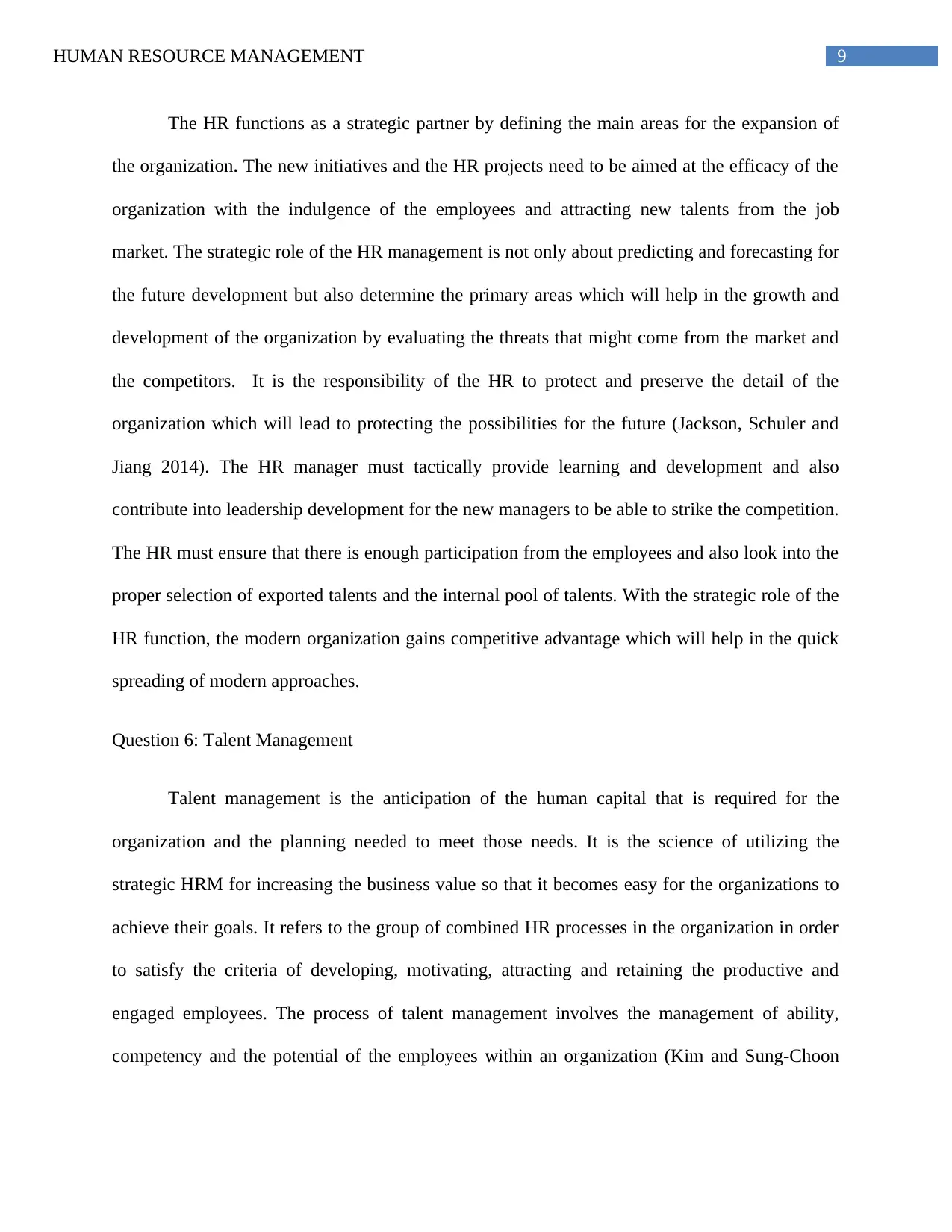
9HUMAN RESOURCE MANAGEMENT
The HR functions as a strategic partner by defining the main areas for the expansion of
the organization. The new initiatives and the HR projects need to be aimed at the efficacy of the
organization with the indulgence of the employees and attracting new talents from the job
market. The strategic role of the HR management is not only about predicting and forecasting for
the future development but also determine the primary areas which will help in the growth and
development of the organization by evaluating the threats that might come from the market and
the competitors. It is the responsibility of the HR to protect and preserve the detail of the
organization which will lead to protecting the possibilities for the future (Jackson, Schuler and
Jiang 2014). The HR manager must tactically provide learning and development and also
contribute into leadership development for the new managers to be able to strike the competition.
The HR must ensure that there is enough participation from the employees and also look into the
proper selection of exported talents and the internal pool of talents. With the strategic role of the
HR function, the modern organization gains competitive advantage which will help in the quick
spreading of modern approaches.
Question 6: Talent Management
Talent management is the anticipation of the human capital that is required for the
organization and the planning needed to meet those needs. It is the science of utilizing the
strategic HRM for increasing the business value so that it becomes easy for the organizations to
achieve their goals. It refers to the group of combined HR processes in the organization in order
to satisfy the criteria of developing, motivating, attracting and retaining the productive and
engaged employees. The process of talent management involves the management of ability,
competency and the potential of the employees within an organization (Kim and Sung-Choon
The HR functions as a strategic partner by defining the main areas for the expansion of
the organization. The new initiatives and the HR projects need to be aimed at the efficacy of the
organization with the indulgence of the employees and attracting new talents from the job
market. The strategic role of the HR management is not only about predicting and forecasting for
the future development but also determine the primary areas which will help in the growth and
development of the organization by evaluating the threats that might come from the market and
the competitors. It is the responsibility of the HR to protect and preserve the detail of the
organization which will lead to protecting the possibilities for the future (Jackson, Schuler and
Jiang 2014). The HR manager must tactically provide learning and development and also
contribute into leadership development for the new managers to be able to strike the competition.
The HR must ensure that there is enough participation from the employees and also look into the
proper selection of exported talents and the internal pool of talents. With the strategic role of the
HR function, the modern organization gains competitive advantage which will help in the quick
spreading of modern approaches.
Question 6: Talent Management
Talent management is the anticipation of the human capital that is required for the
organization and the planning needed to meet those needs. It is the science of utilizing the
strategic HRM for increasing the business value so that it becomes easy for the organizations to
achieve their goals. It refers to the group of combined HR processes in the organization in order
to satisfy the criteria of developing, motivating, attracting and retaining the productive and
engaged employees. The process of talent management involves the management of ability,
competency and the potential of the employees within an organization (Kim and Sung-Choon
Paraphrase This Document
Need a fresh take? Get an instant paraphrase of this document with our AI Paraphraser
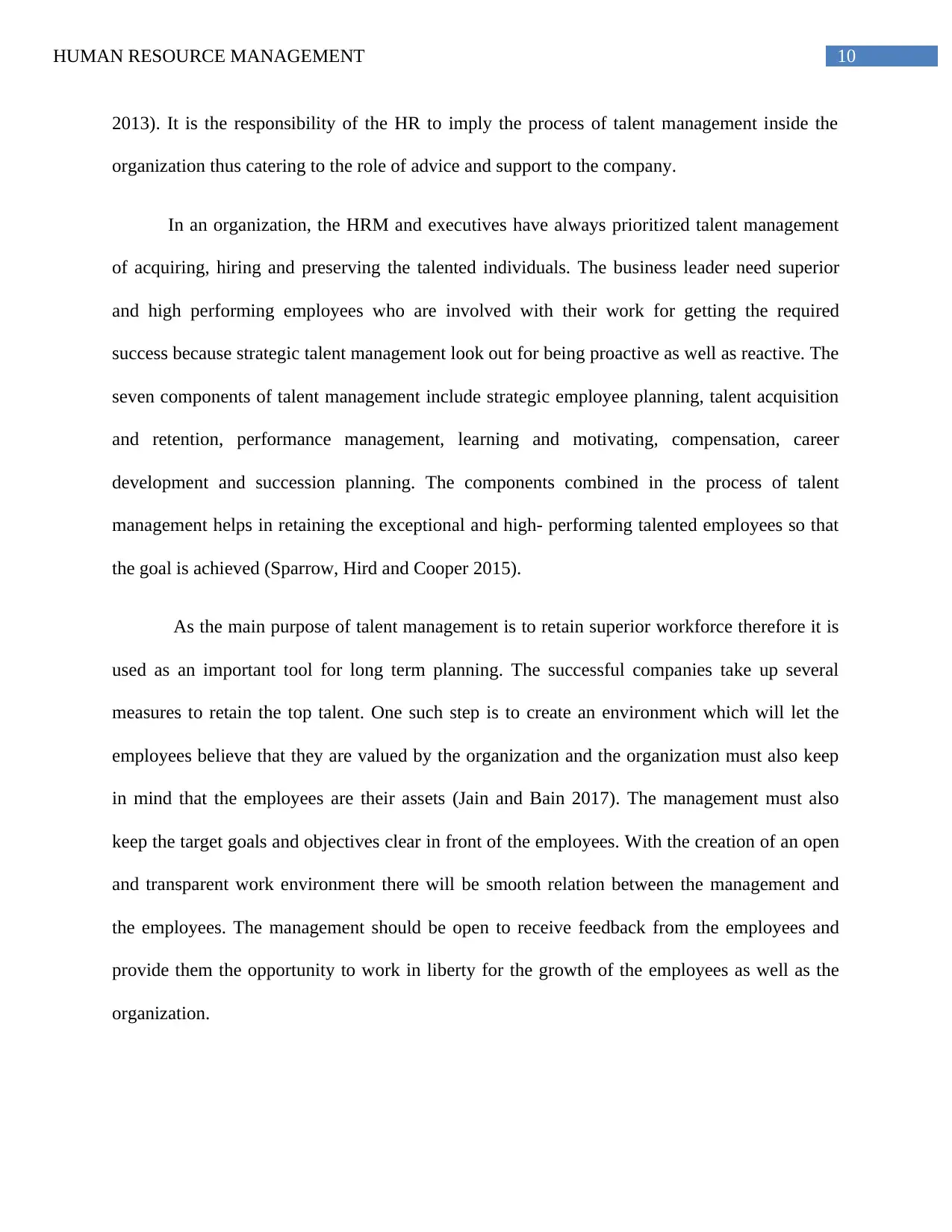
10HUMAN RESOURCE MANAGEMENT
2013). It is the responsibility of the HR to imply the process of talent management inside the
organization thus catering to the role of advice and support to the company.
In an organization, the HRM and executives have always prioritized talent management
of acquiring, hiring and preserving the talented individuals. The business leader need superior
and high performing employees who are involved with their work for getting the required
success because strategic talent management look out for being proactive as well as reactive. The
seven components of talent management include strategic employee planning, talent acquisition
and retention, performance management, learning and motivating, compensation, career
development and succession planning. The components combined in the process of talent
management helps in retaining the exceptional and high- performing talented employees so that
the goal is achieved (Sparrow, Hird and Cooper 2015).
As the main purpose of talent management is to retain superior workforce therefore it is
used as an important tool for long term planning. The successful companies take up several
measures to retain the top talent. One such step is to create an environment which will let the
employees believe that they are valued by the organization and the organization must also keep
in mind that the employees are their assets (Jain and Bain 2017). The management must also
keep the target goals and objectives clear in front of the employees. With the creation of an open
and transparent work environment there will be smooth relation between the management and
the employees. The management should be open to receive feedback from the employees and
provide them the opportunity to work in liberty for the growth of the employees as well as the
organization.
2013). It is the responsibility of the HR to imply the process of talent management inside the
organization thus catering to the role of advice and support to the company.
In an organization, the HRM and executives have always prioritized talent management
of acquiring, hiring and preserving the talented individuals. The business leader need superior
and high performing employees who are involved with their work for getting the required
success because strategic talent management look out for being proactive as well as reactive. The
seven components of talent management include strategic employee planning, talent acquisition
and retention, performance management, learning and motivating, compensation, career
development and succession planning. The components combined in the process of talent
management helps in retaining the exceptional and high- performing talented employees so that
the goal is achieved (Sparrow, Hird and Cooper 2015).
As the main purpose of talent management is to retain superior workforce therefore it is
used as an important tool for long term planning. The successful companies take up several
measures to retain the top talent. One such step is to create an environment which will let the
employees believe that they are valued by the organization and the organization must also keep
in mind that the employees are their assets (Jain and Bain 2017). The management must also
keep the target goals and objectives clear in front of the employees. With the creation of an open
and transparent work environment there will be smooth relation between the management and
the employees. The management should be open to receive feedback from the employees and
provide them the opportunity to work in liberty for the growth of the employees as well as the
organization.
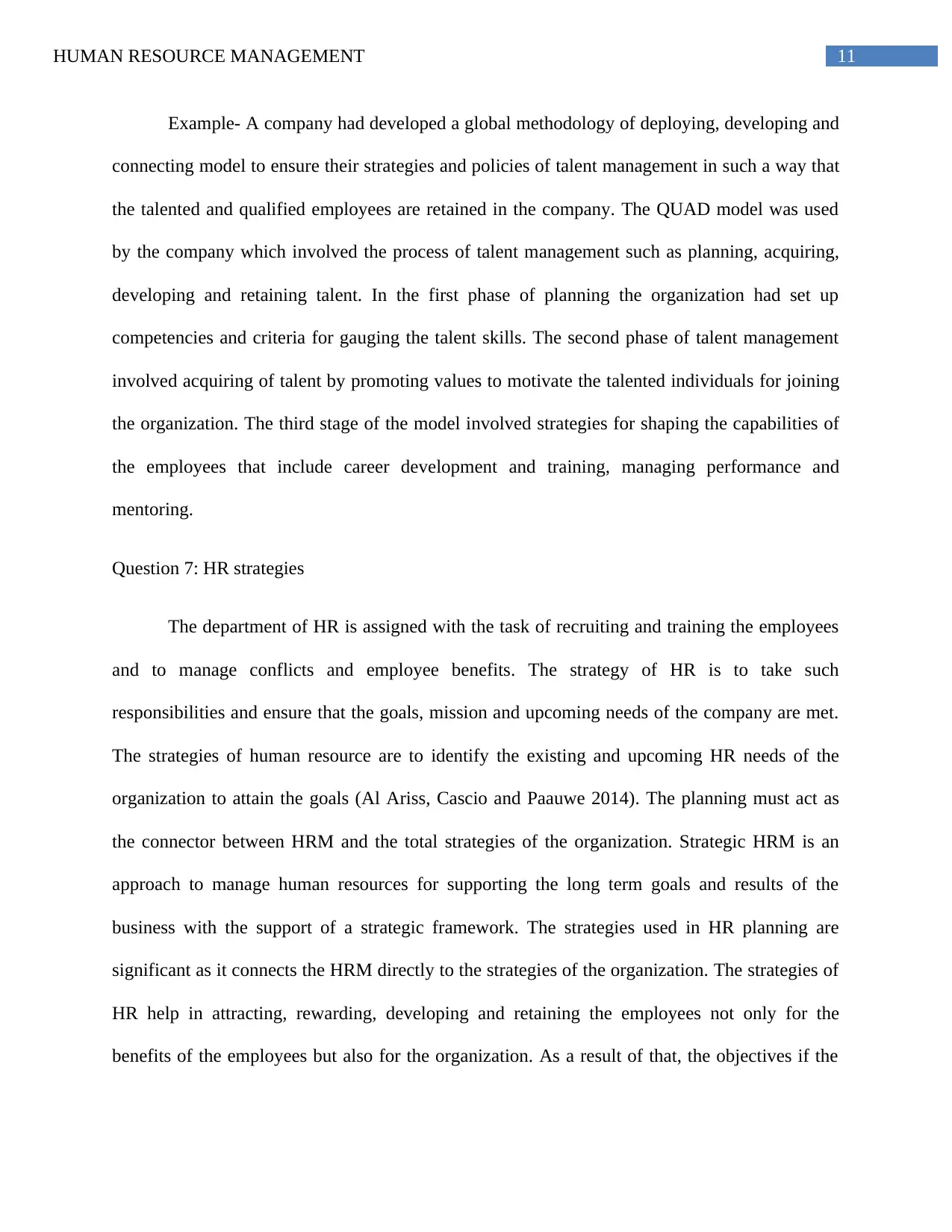
11HUMAN RESOURCE MANAGEMENT
Example- A company had developed a global methodology of deploying, developing and
connecting model to ensure their strategies and policies of talent management in such a way that
the talented and qualified employees are retained in the company. The QUAD model was used
by the company which involved the process of talent management such as planning, acquiring,
developing and retaining talent. In the first phase of planning the organization had set up
competencies and criteria for gauging the talent skills. The second phase of talent management
involved acquiring of talent by promoting values to motivate the talented individuals for joining
the organization. The third stage of the model involved strategies for shaping the capabilities of
the employees that include career development and training, managing performance and
mentoring.
Question 7: HR strategies
The department of HR is assigned with the task of recruiting and training the employees
and to manage conflicts and employee benefits. The strategy of HR is to take such
responsibilities and ensure that the goals, mission and upcoming needs of the company are met.
The strategies of human resource are to identify the existing and upcoming HR needs of the
organization to attain the goals (Al Ariss, Cascio and Paauwe 2014). The planning must act as
the connector between HRM and the total strategies of the organization. Strategic HRM is an
approach to manage human resources for supporting the long term goals and results of the
business with the support of a strategic framework. The strategies used in HR planning are
significant as it connects the HRM directly to the strategies of the organization. The strategies of
HR help in attracting, rewarding, developing and retaining the employees not only for the
benefits of the employees but also for the organization. As a result of that, the objectives if the
Example- A company had developed a global methodology of deploying, developing and
connecting model to ensure their strategies and policies of talent management in such a way that
the talented and qualified employees are retained in the company. The QUAD model was used
by the company which involved the process of talent management such as planning, acquiring,
developing and retaining talent. In the first phase of planning the organization had set up
competencies and criteria for gauging the talent skills. The second phase of talent management
involved acquiring of talent by promoting values to motivate the talented individuals for joining
the organization. The third stage of the model involved strategies for shaping the capabilities of
the employees that include career development and training, managing performance and
mentoring.
Question 7: HR strategies
The department of HR is assigned with the task of recruiting and training the employees
and to manage conflicts and employee benefits. The strategy of HR is to take such
responsibilities and ensure that the goals, mission and upcoming needs of the company are met.
The strategies of human resource are to identify the existing and upcoming HR needs of the
organization to attain the goals (Al Ariss, Cascio and Paauwe 2014). The planning must act as
the connector between HRM and the total strategies of the organization. Strategic HRM is an
approach to manage human resources for supporting the long term goals and results of the
business with the support of a strategic framework. The strategies used in HR planning are
significant as it connects the HRM directly to the strategies of the organization. The strategies of
HR help in attracting, rewarding, developing and retaining the employees not only for the
benefits of the employees but also for the organization. As a result of that, the objectives if the
⊘ This is a preview!⊘
Do you want full access?
Subscribe today to unlock all pages.

Trusted by 1+ million students worldwide
1 out of 23
Related Documents
Your All-in-One AI-Powered Toolkit for Academic Success.
+13062052269
info@desklib.com
Available 24*7 on WhatsApp / Email
![[object Object]](/_next/static/media/star-bottom.7253800d.svg)
Unlock your academic potential
Copyright © 2020–2025 A2Z Services. All Rights Reserved. Developed and managed by ZUCOL.



